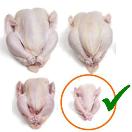Bigger may be better, but less popular

In a session called “Big Bird Programs: The Customer Perspective,†a panel representing the customer viewpoint examined the US chicken industry’s ‘big bird’ production programs which create more and more heft per broiler.
Big birds may be popular with processors, but consumers still like smaller birds better. John Hauptman, vice president of retail consulting firm Willard Bishop, explained that big birds (from flocks sometimes averaging eight pounds per bird) can pose economic and quality issues for retailers.
The optimal size for whole fryers at retail is considered to be around three pounds dressed weight. While parts from birds larger than the optimal size may make a great presentation in the service case and produce a higher ring at the cash register, there are drawbacks. If whole fryers are too large, quality concerns can result. The meat can be tougher and less flavourful to consumers.
Ken Parnell of Parnell Leaton Consulting, and former vice president of purchasing for Wal-Mart, detailed the progression in bird weights. In the 1970s, individual bird weights tended to range from 2.0 to 2.25 pounds. Now, in the 2000s, 13-pound broilers are not unheard of around the industry. Parnell said that these birds and parts would need to be pumped or marinated to be acceptable, and companies/retailers will need to develop marination and cooking processes to meet the challenge.
Mike Sobel, director of purchasing for Zaxby’s, said that Zaxby customers prefer the smaller tenders five to one in taste tests. Although it is more cost effective to produce larger birds, Sobel suggested the industry search for a way to produce smaller birds more economically, for the production of the smaller tenders.













